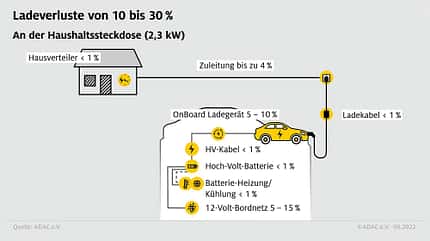Charging loss in electric cars: This is how much electricity is really lost during charging

The ADAC (German Automobile Club) conducted measurements and found significant differences and, in some cases, significant charging losses. In addition to charging at a wall outlet with 2.3 kilowatts, EV owners can charge at their wallbox with up to 11 kW – in some cases even 22 kW. There's also the option of operating the wallbox with reduced charging power. This can occur when multiple vehicles are being charged or when using electricity from a photovoltaic system.
The automobile club used four models for the test: the Renault Zoe, the VW ID.3, the Tesla Model 3, and the Fiat 500e. The Renault Zoe experienced the highest charging loss at the socket, at 24.2 percent.

ADAC
The measurement results favor the wallbox for all four test vehicles. The Fiat 500e achieved the lowest charging loss at just 6.3 percent using the 11 kW wallbox.
For charging from a household socket, the on-board charger must convert the alternating current into direct current. Charging losses already occur here. In addition, the twelve-volt electrical system consumes power, as various control units are active during charging. The components controlling the charging process require between 100 and 300 watts.

ADAC
The power cable to the socket can also contribute to losses; according to the ADAC, losses of up to four percent are possible and even permissible. However, the household distribution board, charging cable, high-voltage cable, and the car's battery have only a minor impact. Overall, charging losses at household sockets amount to ten to 30 percent .
Here, the charging power is higher and occurs in three phases. The supply cable is more powerful, but charging losses still occur during conversion in the on-board charger.

ADAC
Because the battery charges faster via the wallbox, the operating times of the auxiliary devices are also shorter. Accordingly, charging losses at the wallbox add up to five to ten percent .
The higher the charging power, the shorter the charging process and the lower the losses. The ADAC recommends charging the electric car at the wallbox with maximum charging power. The charging range makes little difference – for example, whether the battery is charged by 20 or 50 percent. In concrete terms, this means: If you consistently charge the Renault Zoe at the wallbox, there are 14.3 percent fewer charging losses. This would save you €120 a year on your electricity bill for a mileage of 10,000 kilometers. Incidentally, when charging at a public charging station, the electricity conversion does not take place in the vehicle, but in the charging station. The charging losses therefore occur at the operator's site. However, the temperature control of a battery that is too hot or too cold consumes additional electricity.
You can see a market overview of all electric cars in our photo show.
auto-motor-und-sport





